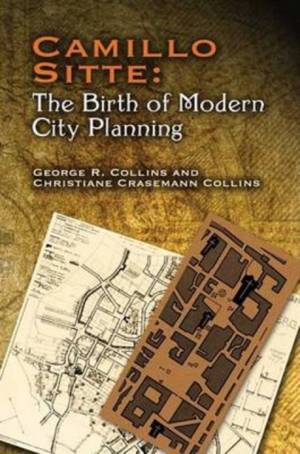
Door een staking bij bpost kan je online bestelling op dit moment iets langer onderweg zijn dan voorzien. Dringend iets nodig? Onze winkels ontvangen jou met open armen!
- Afhalen na 1 uur in een winkel met voorraad
- Gratis thuislevering in België vanaf € 30
- Ruim aanbod met 7 miljoen producten
Door een staking bij bpost kan je online bestelling op dit moment iets langer onderweg zijn dan voorzien. Dringend iets nodig? Onze winkels ontvangen jou met open armen!
- Afhalen na 1 uur in een winkel met voorraad
- Gratis thuislevering in België vanaf € 30
- Ruim aanbod met 7 miljoen producten
Zoeken
Camillo Sitte: The Birth of Modern City Planning
With a Translation of the 1889 Austrian Edition of His City Planning According to Artistic Principles
Christiane Crasemann Collins, George R Collins, Camillo Sitte
€ 27,45
+ 54 punten
Omschrijving
First published in 1889, this revolutionary text by a noted Austrian architect and urban planner ignited a new age of city planning. Inspired by medieval and baroque designs, Camillo Sitte emphasized the creation of spacious plazas, enhanced by monuments and other aesthetic elements.
Numerous illustrations highlight this classic, which features extensive commentary, notes, and a bibliography. The acclaimed translation and commentary by George R. Collins and Christiane Crasemann Collins includes Sitte's original drawings and plates in a format resembling the original publication. The authors place Sitte's work within the context of its historical and theoretical background, and they establish its relevance to such recent developments in urban theory as the townscape movement and contextualism.
Numerous illustrations highlight this classic, which features extensive commentary, notes, and a bibliography. The acclaimed translation and commentary by George R. Collins and Christiane Crasemann Collins includes Sitte's original drawings and plates in a format resembling the original publication. The authors place Sitte's work within the context of its historical and theoretical background, and they establish its relevance to such recent developments in urban theory as the townscape movement and contextualism.
Specificaties
Betrokkenen
- Auteur(s):
- Uitgeverij:
Inhoud
- Aantal bladzijden:
- 480
- Taal:
- Engels
- Reeks:
Eigenschappen
- Productcode (EAN):
- 9780486451183
- Verschijningsdatum:
- 15/12/2006
- Uitvoering:
- Paperback
- Formaat:
- Trade paperback (VS)
- Afmetingen:
- 155 mm x 234 mm
- Gewicht:
- 635 g

Alleen bij Standaard Boekhandel
+ 54 punten op je klantenkaart van Standaard Boekhandel
Beoordelingen
We publiceren alleen reviews die voldoen aan de voorwaarden voor reviews. Bekijk onze voorwaarden voor reviews.











